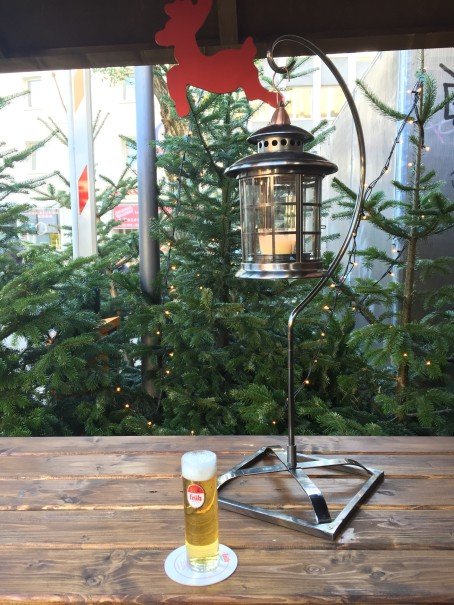
Once You Go Kölsch, You Never Go Back

Once You Go Kölsch, You Never Go Back
Beer in Cologne
I had always thought beer was best enjoyed as a pilsener in deep, hearty glasses. Perching on a bench adjoining a tightly packed bar in Cologne, my mind was changed. “We do things differently around here,” the bartender seemed to indicate with his bulging eyes, as he gripped a pencil in one hand and gestured for my bar mat with the other. After he scrawled two dashes on the mat, indicating the beers I had ordered, I was presented with two glasses of Kölsch, delivered in 0.2-liter glasses known as a Stangen, or rods.
In December, much of Cologne is dedicated to the famous Weihnachtsmarkt. Every square, courtyard, and spare patch of land in the city is given over to the festive celebrations. Sparkling lights are ubiquitous, and stalls selling everything from gingerbread houses to arts and crafts dominate public space. Here, the deep red glühwein has hegemony, along with sizzling bratwurst. But dotted in between the glühwein drinkers, the golden rods of Kölsch are still visible throughout the markets. Many stay true to the drink that serves the city the whole year round.
Moving inside the bar, I order two more, and then two more, each time having the requisite number of scribbles added to my beer mat. The tall, thin glasses are used because Kölsch is top-fermented, meaning that it flattens quicker than other beers. The incentive is to drink in short, sharp bursts, with more forthcoming almost as soon as one has been sunk. I oblige, and the evening starts to develop a golden hue.
The bartender is also drinking and starts to warm up, delivering the beer around the bar in circular Kranz trays, held by a handle that shoots out of the middle. He asks me where I’m from and, after a quick probing about the various merits of Manchester, begins to extol the virtues of Kölsch, rubbishing the pilsener that he also serves (with great reluctance).
Everywhere in Cologne, people are proud of their local brew. Germany has many regional variations in dialect, wealth, and geography, but drinking gets to the heart of local culture. On any street in the city, the trademarks of Cologne’s three main Kölsch companies—Früh, Gaffel, and Reissdorf—beam out from bars and kiosks. The drink is inseparable from the city.
After draining a few more glasses, I have to leave the bar and the bartender, just as he is set to launch into an exposition of the different Kölsch companies. I take the train to Gelsenkirchen, a small mining city in the Ruhr region, to watch Schalke, the local soccer team, take on Hannover in the Bundesliga. The journey hums along nicely and an extended stop at Duisburg station allows me to jump off and collect some more beer from a kiosk on the platform. But something isn’t right. The pilsener is heavy, the bottle is big and I find myself lost without the light taste of Kölsch and swift gulps of the tall, thin Stange glasses. I’ve changed, irreversibly.